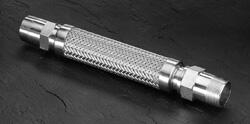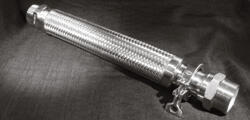Flex-Connectors: Swivels vs. Mechanical Clamps
By: Erik Kane
Let’s talk about PEI flex connectors. There’s no two-ways about it: underground sumps are tight spaces. Working in and around them can be really tough, but their job as a safety and environmental containment system are crucial for a service station. Because of this, piping configurations in sumps that are long-lasting and easy to install that also minimize the time and effort required to construct and maintain are ideal! Flex-connectors play a big part in making that happen: they adjust for any misalignment, relieve shock and vibration from the rigid piping, and can be made to last. But when it comes to installation, there are two major ways to configure a flex-connector to really make it easier to install: by using a swivel, or a 2-part mechanical clamp.
Old School: Swivel End-Fitting
Rigid connectors (direct-attached fittings) were the standard in the industry for years, and it’s still not uncommon for service station owners to use rigid flex-connectors today to save on cost. You still get the benefits of using the flex, but the installation can be bothersome to the point that it may also result in a poor connection that can compromise system performance. The only option was to use a cumbersome adapter fitting which added to the fitting length and reduced the available flexible length of the connector. Enter the swivel fitting. Manufacturers got wise to this issue, and started to design their own integral swivel fittings to meet the petroleum equipment industry’s requirements. By allowing one end of the flex to swivel freely, it makes it much easier to get the flex-connector into place and install it without damaging the hose or torquing it. Today, especially in the eyes of most installers and contractors, swivel fittings are the preferred configuration for flex-connectors to aid in installation.
New School: Mechanical Clamps
Recently, a new trend has emerged that has taken the benefits offered by swivels to a new level. First appearing on the West coast, the use of sanitary flanges (originally designed for food-grade applications) as a method for connecting one or both end fittings to the flex-connector became popular, and spread East as it caught on. The main idea behind by the sanitary flanges is essentially the same as the swivel: to leave at least one end of the hose unrestricted during installation to make the process easier. But because the fittings are not permanently affixed to the end of the hose, you can take the fitting completely off, install the loose fitting, install the other end of the hose, and then mechanically clamp the two together without introducing any torque! With the two ends are separated, it also gives the installer more room to work by using two shorter parts instead of wrangling one longer one.
Which is best?
As with most product questions, it always comes down to the application! But there are benefits and drawbacks to each:
Swivel Fittings
Pros:
•
Welded
connection
is
the
most
reliable,
with
very
low
risk
of
attachment
issues
•
Less
expensive
than
clamps,
while
still
providing
benefits
over
rigid
fittings
•
Universally
accepted
and
approved
for
fuel-service
when
supplied
by
a
certified
manufacturer
Cons:
•
Not
always
available
in
all
material
types
for
newer
fuel
blends
•
Bulkier
to
install
and
require
the
use
of
tools
•
Swivel
configurations
often
limited
to
one
end
and
a
single
fitting,
whereas
clamps
can
be
stacked
Clamp Fittings
Pros:
•
Extremely
easy
to
install
(and
service),
saving
time
and
preventing
poor
installations
that
would
torque
or
damage
the
connector
•
All-stainless
design
makes
them
reliable
and
compatible
with
many
fuel
types
•
Ability
to
add,
subtract,
or
stack
fittings
and
change
configuration
on
the
fly
Cons:
•
Gasket
used
to
make
the
connection
must
be
installed
properly
on-site
(and
be
fuel-compatible)
•
Not
always
approved
for
fuel
transfer
(can
vary
by
state
or
local
laws)
•
High
quality
fittings,
but
come
at
a
slightly
higher
price
In many cases, either style can often do the job, but preference can make a big difference! If there are a lot of flex-connectors in a given sump, it may be easier to install them all in the tight space using clamps. If speed is required, going with a more common connector that’s likely to be stocked (swivel) may reduce lead-time and get it to the installation site more quickly. There are many factors that can affect the decision when choosing between the two! Hose Master has been manufacturing products for the PEI industry for nearly 30 years, and we make both types of flex-connectors. So if you have application questions or concerns or want more information on our FireShield products, contact us and we would be happy to help you!


Copyright 2019, Hose Master, LLC
All Rights Reserved
-
When to Use Flexible Metal Products
-
Select the Right Hose for Your Application
-
Select the Right Corrugated Metal Hose
-
Select the Right Stripwound Metal Hose
